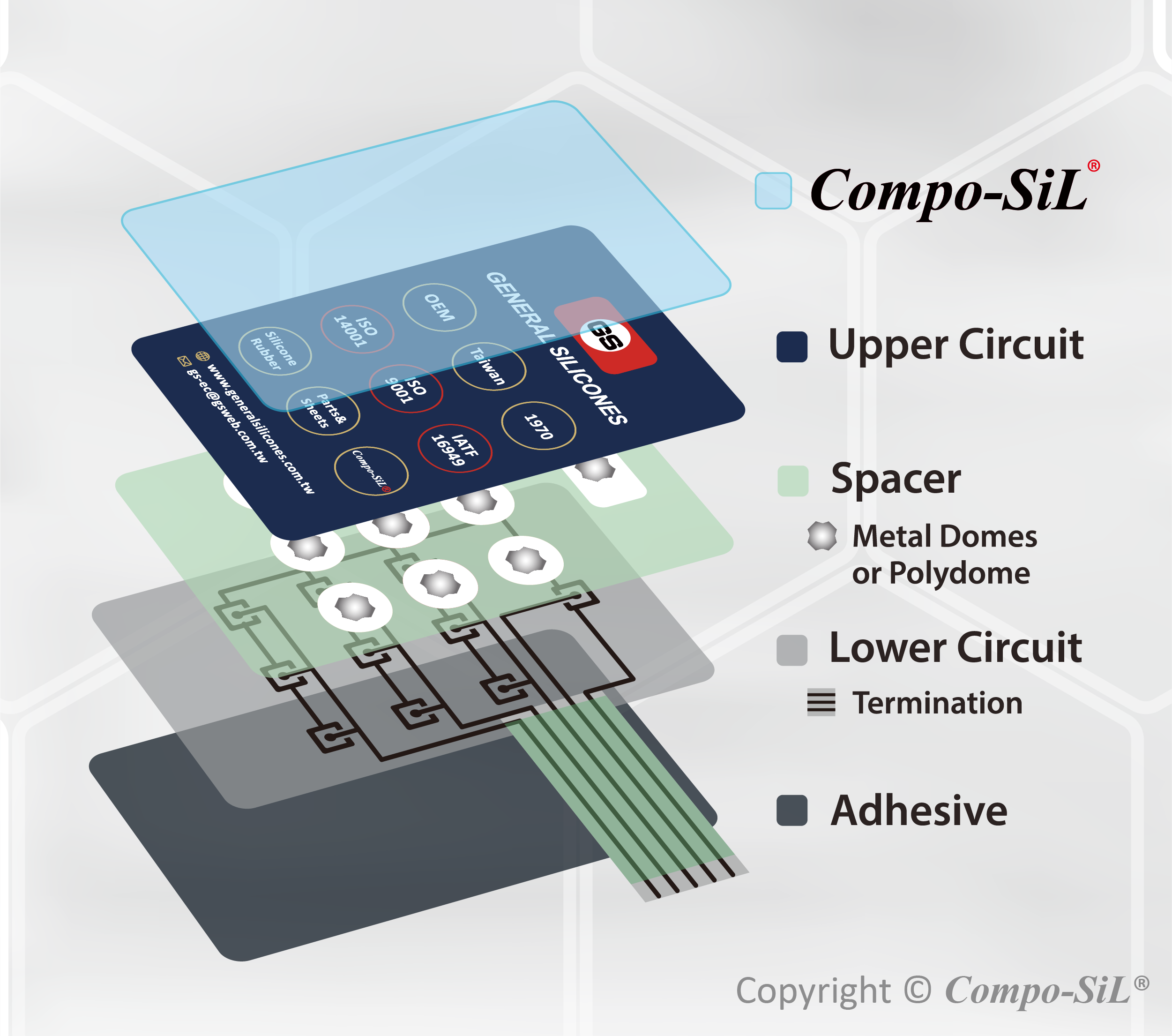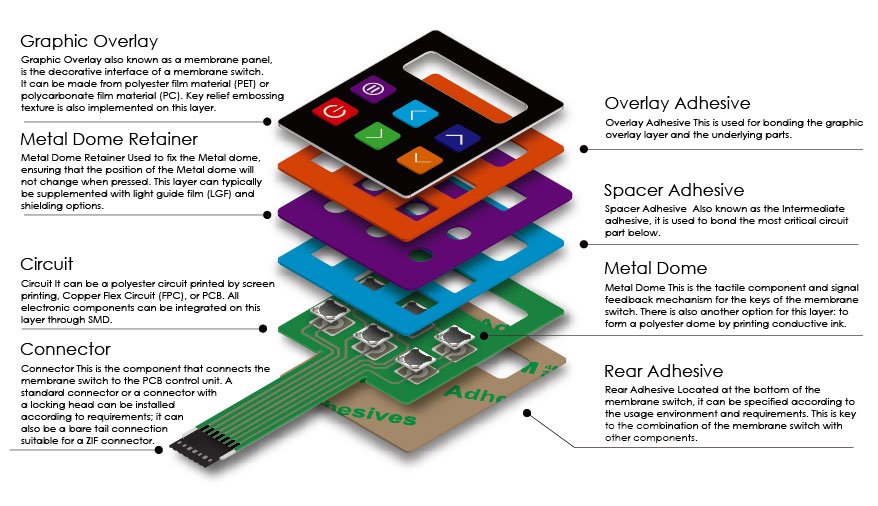Membrane switch integration strategies for modern manufacturing
Wiki Article
The Production Process Behind Membrane Switch: What You Required to Know
The manufacturing procedure behind membrane layer switches combines careful layout, material selection, and high quality control. It begins with recognizing the details of membrane layer button design and proceeds through numerous stages, consisting of material options and printing techniques. Each phase plays a vital duty in making sure capability and toughness. The complexities of layer building and construction and the rigorous testing requirements might reveal insights that are not quickly apparent. What lies past these fundamental elements?Comprehending Membrane Layer Switch Over Style
Although membrane layer buttons might appear easy at initial look, their design involves complex factors to consider that assure functionality and sturdiness. The style procedure starts with a comprehensive understanding of individual demands, including the interface's designated application and environmental elements. Comfort designs is a crucial element, as the layout must facilitate ease of usage while making certain that responsive responses fulfills customer expectations.Moreover, the layering of parts, such as visuals overlays, glue layers, and conductive traces, have to be specifically crafted. membrane switch. This split setup not only influences the switch's responsiveness but also impacts its longevity. Focus is provided to the securing methods utilized to safeguard against moisture and dirt, which can jeopardize performance. Additionally, layout factors to consider expand to appearances, where color design and aesthetic clearness enhance user experience. Ultimately, the layout of membrane layer switches over equilibriums performance, individual experience, and sturdiness, making certain that they fulfill the needs of different applications efficientlyProducts Used in Membrane Layer Change Production
When choosing materials for membrane layer switch production, it is important to ponder both performance and resilience. The key materials consist of polyester and polycarbonate films, which supply versatility and strength. These films are often covered with glue to ensure correct bonding to substrates. Conductive inks, commonly composed of silver or carbon, are critical for producing electric connections within the button, permitting trustworthy operation.Additionally, a protective layer, such as a difficult coat, is often used to enhance scrape resistance and longevity. The option of backing product, such as acrylic or foam, can considerably influence the switch's tactile feeling and overall individual experience. In addition, various ecological variables, including temperature level and humidity, must guide material option to assure peak performance in particular applications. Eventually, the appropriate combination of materials contributes to the membrane switch's performance and life-span, making educated choices important for makers.The Printing Refine: Creating Video and Text
The printing procedure in membrane layer button production plays a considerable duty in generating high-grade graphics and message. Various visuals design techniques are employed to guarantee visual appeal and functionality, while careful ink selection methods are essential for sturdiness and performance. Comprehending these aspects is fundamental for achieving finest results in membrane switch layout.Graphic Style Techniques
Graphic design techniques play a vital role in the printing process of membrane layer switches, as they define just how graphics and message will eventually appear on the final product. Reliable visuals style involves the strategic usage of formats, font styles, and shades to improve readability and visual allure. Designers often use vector graphics for scalability, guaranteeing that photos stay sharp at various sizes. In addition, interest to comparison and alignment is essential, as it influences customer interaction and visual quality. The consolidation of branding components, such as logos, must be managed with like preserve brand name integrity. Generally, thoughtful graphic layout techniques add substantially to the functionality and appearance of membrane layer switches, affecting customer experience and item performance.Ink Choice Approaches
Selecting the suitable ink is crucial for achieving the preferred visual quality and resilience in membrane switch manufacturing. Numerous ink kinds are utilized, including solvent-based, water-based, and UV-curable inks. Each type uses distinctive characteristics, such as flexibility, adhesion, and resistance to ecological aspects. Solvent-based inks are often favored for their resilience and lively shades, while water-based inks are a lot more eco pleasant yet might have restrictions in bond. UV-curable inks supply fast treating and robust performance. Furthermore, color matching techniques guarantee that the selected inks align with layout requirements. Inevitably, the selection of ink need to think about aspects such as application technique, substratum compatibility, and end-use demands to accomplish exceptional results in membrane switch graphics and text.Layer Building and Assembly

Material Option Refine
A mindful selection of materials is important in the manufacturing process of membrane layer buttons, as it straight affects capability and longevity. The primary materials used include polyester, polycarbonate, and various conductive inks. Polyester is typically favored for its exceptional resistance to chemicals and abrasion, making it ideal for rough settings. Polycarbonate, on the various other hand, provides superior clarity and impact resistance, which is advantageous for applications needing exposure and toughness. Conductive inks, normally made up of silver or carbon, are crucial for producing trustworthy electric paths. Furthermore, the choice of adhesive materials influences the total honesty of the switch - membrane switch. Assessing elements such as environmental direct exposure, responsive comments, and aesthetic requirements overviews explanation makers in choosing the most effective materials for their details applicationsLayer Attachment Methods
Adhering layers in membrane layer button building is an important process that assures performance and longevity. Various bond methods are employed to safeguard suitable bonding between layers, which typically consist of making use of adhesives, heat, and stress. Pressure-sensitive adhesives (PSAs) are commonly made use of for their simplicity of application and prompt bonding abilities. Additionally, thermal bonding strategies can be applied, where warmth is used to turn on adhesive homes, securing a strong bond. The selection of bond approach mostly relies on the materials entailed and the specific application demands of the membrane layer switch. Correct alignment and consistent application of adhesives are necessary to stop defects, protecting the button operates efficiently throughout its desired lifespan.High Quality Control Actions
Ensuring quality assurance during the layer building and setting up of membrane buttons is crucial for preserving efficiency and reliability. This process commonly involves a number of essential measures, including thorough evaluations at each phase of production. Producers use innovative screening approaches, such as peel tests and bond analyses, to verify the honesty of layer bonds. In addition, visual evaluations are performed to recognize any problems in printing or material variances. Environmental conditions, such as temperature and moisture, are carefully kept an eye on to assure excellent curing and adhesion. Normal calibration of devices assists preserve accurate manufacturing standards. By implementing these quality control measures, manufacturers can greatly lower the threat of item failure, guaranteeing that the last membrane layer changes meet the required requirements and consumer expectations.Evaluating and Quality Assurance Actions

Developments in Membrane Switch Over Innovation
As advancements in modern technology proceed to develop, membrane buttons are gaining from innovative growths that improve their functionality and customer experience. One significant development is the integration of capacitive touch technology, which enables for more intuitive and receptive interface. This change not only boosts looks but additionally decreases mechanical damage, prolonging the life-span of the switches.Additionally, improvements in visuals overlay materials have actually resulted in boosted sturdiness and resistance to environmental aspects such as moisture and UV light. These materials currently provide boosted clarity and illumination, more elevating the aesthetic appeal.Furthermore, the unification of wise modern technology is transforming membrane layer switches over into interactive control board, enabling connectivity with IoT tools. This connectivity promotes a smooth customer experience, paving the method for applications in different sectors, from healthcare to consumer electronic devices. Jointly, these developments setting membrane layer switches over as crucial elements in modern-day device design.Often Asked Concerns
Just how Lengthy Does the Membrane Change Production Refine Take?
The period of the membrane switch production procedure can differ substantially. Factors such as complexity, products made use of, and production volume influence timelines, with common production ranging from a few days to several weeks for completion.What Are the Common Applications for Membrane Switches?
Membrane switches are commonly utilized in various industries, consisting of auto controls, house devices, clinical tools, and customer electronic devices (membrane switch). Their adaptability and toughness make them excellent for applications calling for easy to use user interfaces and reputable performance in diverse environmentsCan Membrane Layer Switches Over Be Personalized for Particular Needs?

What Is the Life-span of a Regular Membrane Change?
The life expectancy of a regular membrane layer switch varies, but typically, it varies from 1 to 5 million cycles. Variables such as use, setting, and material quality significantly influence durability and overall performance in time.

Are Membrane Layer Switches Over Eco-friendly?
The environmental friendliness of membrane switches differs. Some products utilized may membrane switch not be recyclable, while others can be environment-friendly. The general impact depends on making materials and techniques, demanding cautious consideration throughout option and disposal. The manufacturing process behind membrane layer changes combines careful design, product choice, and quality control. It starts with comprehending the complexities of membrane layer button design and progresses with different phases, consisting of material selections and printing methods. When selecting products for membrane button production, it is crucial to consider both performance and sturdiness. A careful option of materials is vital in the manufacturing procedure of membrane buttons, as it straight influences capability and toughness. The option of attachment technique largely depends on the products included and the specific application demands of the membrane button.Report this wiki page